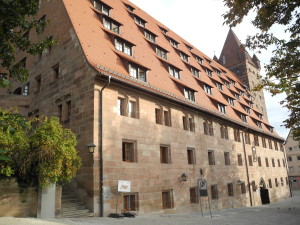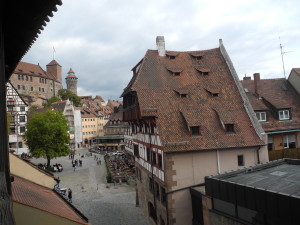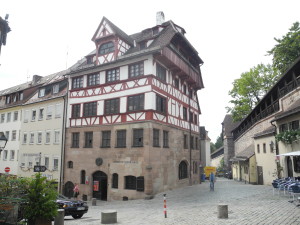When my wife and I were in Nuremberg, Germany, this past September, we stayed for four nights in a lodging that was adjoined to the Imperial Castle that sits on the highest point in the city.
It was a short stroll to the castle entrance and all the other landmarks of the old city, which has been beautifully restored after its destruction in World War II.
It was five-to-ten minute downhill walk to the Hauptmarkt, or Market Square. The Albrecht Durer Haus — where Germany’s most celebrated painter lived — is even closer. The main train station is about a mile away.
We had a sparkling clean room with a view, a private bathroom, and a gigantic German buffet breakfast — wonderful breads, cheeses, meats, fruit, yogurts, eggs, juices and coffee (including espresso drinks) — that was included in the rates. The rates themselves were about half of what we would have paid for a moderately priced hotel in the old city.
The name of the lodging was the Jugendherberge Nurnberg, which translates to Nuremberg Youth Hostel.
But, you may wonder, how can a baby boomer couple find refuge in a youth hostel, with a private bathroom, no less?
A number of people have asked us just that.
The simple answer is that European youth hostels aren’t just for youth any more. And they aren’t limited to just dorm-room style accommodations, often shared with strangers.
When we entered the youth hostel, no one at the front desk looked at us like “What are you doing here?” The folks at the desk remained friendly and helpful throughout, offering advice and assistance when needed.
We did have to join the International Youth Hostel Federation, which cost about $10 each for a year’s membership.
And we had to buy soap and shampoo for use during our stay, which proved to be a minor expense once we figured out the German word for “shampoo.” Free Wi-Fi (available in the public rooms) easily made up for that. The hostel provided towels and bedding.
Not For Everyone
If you’re looking for luxury and lots of amenities, this hostel would not be for you. There was no TV in the room, and the furniture was spartan.
We spent most of our time exploring the city anyway, so the lack of a TV and other amenities didn’t bother us. The only real downside for us was that we had to sleep in bunk beds, though there were two sets in the room so we each got a bottom bunk. And there was plenty of storage and closet space, which we could lock when we went out.
Yes, there were a good many youths (including school groups) staying at the hostel, but there were also a good many adults — singles, couples, parents, and grandparents — staying there as well.
Quiet time started at 10 p.m. so there were no raucous noises after that. The thick walls of the castle-like structure helped keep noise down at other times. We had keys to the front door if we came in after hours.
In short, all the possible downsides that we had previously associated with youth hostels — our “advanced” age, sharing rooms with others, curfews, lack of private bathrooms — weren’t a problem at all.
Of course, if you want to pay even less — as low as 30 euros — you can reserve a bed or two in a dorm-style room, but my guess is that most baby boomers would opt to pay a bit more for the private room.
Of the hostel’s 93 rooms, 20 are doubles, two are accessible for wheelchairs, and there is one single. The rest sleep from three to six per room. All have en suite bathrooms — attached to the room, not down the hall.
Click here for more information on this hostel.
For my earlier post on the new breed of European luxury hostels that welcome baby boomers, click here.
You can find information on other youth hostels in Nuremberg and elsewhere in Germany and Europe at hostel.com and hostelworld.com.
I’ll have more posts on Nuremberg coming up soon.
Travel Tip of the Day: Nuremberg makes an excellent base for exploring other Bavarian towns and cities like Rothenburg, Bamberg, Wurzburg, and Munich.















Leave a Reply